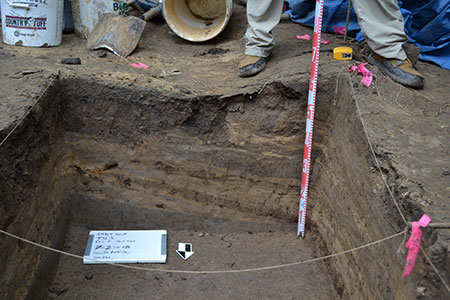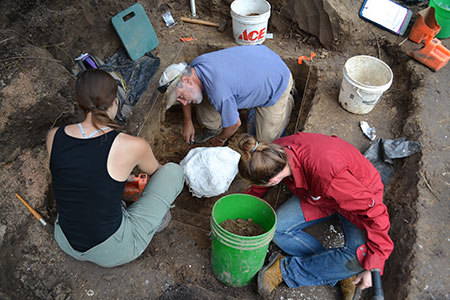Projects—2018
During the 2018 field season, an Odyssey team participated in ongoing excavations at the stratified Magic Mountain site in the foothills of the Rocky Mountains at Golden, Colorado. The Odyssey team investigated deposits at Magic Mountain that were identified through geoarchaeological coring by Dr. Mandel in 2017 with potential for early Paleoindian archaeological materials. The team also conducted text excavations at the newly discovered Pipe Creek site in north-central Kansas where flood scouring exposed Pleistocene-aged fauna associated with a deeply buried soil.
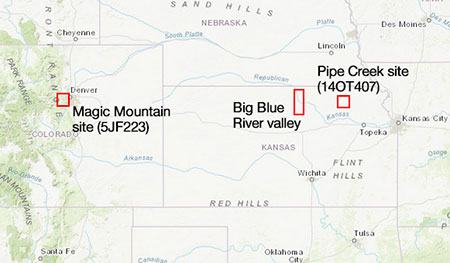
1. Excavations at Magic Mountain site (5JF223) in east-central Colorado
An Odyssey team traveled to Golden, Colorado to join forces with the Denver Museum of Nature and Science and the Paleocultural Research Group for on-going excavations at one of the most important archaeological sites in northeastern Colorado (Photo 1). Recognized for the significance of its stratified early Archaic and Ceramic Period archaeological deposits, Magic Mountain is listed on the National Register of Historic Places. A coring program conducted last year by Dr. Rolfe Mandel, Executive Director of the Odyssey Program, identified areas of the site with potential to contain Paleoindian cultural deposits within a deeply buried soil (Photo 2). This season, Odyssey team members spent two 10-day sessions conducting initial testing of the buried soil to determine if cultural materials are present. Also, Dr. Mandel conducted a detailed geologic investigation at the site. Though no artifacts were exposed in the limited area investigated this year, Odyssey's excavations contributed additional information and significance to this rich archaeological site.
Photo 1. Excavations at Magic Mountain located within the city of Golden, Colorado, in the foothills of the Rocky Mountains.
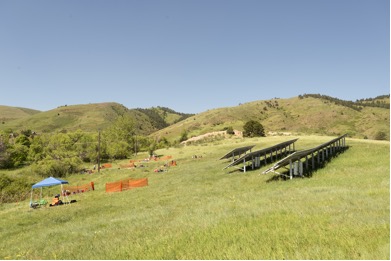
Photo 2. Dr. Mandel stands next to a drill rig at Magic Mountain in 2017; coring was conducted to assess the potential for buried deposits dating to the terminal Pleistocene.
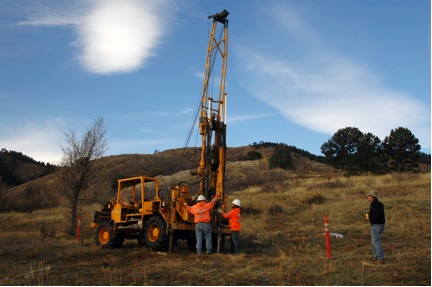
2. Excavations at the Pipe Creek site (14OT407) in Ottawa County, north-central Kansas
Spring floods exposed a deeply buried organic-rich soil dated to 9430±35 yr B.P. and containing chipped stone artifacts and bones attributed to an extinct species of bison. Odyssey crews spent a ten-day session this season excavating six 1x1 meter test units in the buried soil to gain a better understanding of the artifact context and site formation (Photo 1). Text excavations exposed a complex history of erosion, deposition, and landscape stability in a stratigraphic profile (Photo 2). Additional bison bone and chipped stone artifacts were recovered, including an isolated inverted bison skull (Photo 3) sitting on top of the buried soil. Based on the results of the 2018 excavations, these materials occur above the buried soil and were deposited by floodwaters. Ongoing analysis of the stratigraphy and more detailed examination of the bison bones will help explain the formation of the site.
Photo 1. Drone footage of Odyssey excavations at Pipe Creek (14OT407) (Courtesy Tony Layzell, KGS).
Photo 2. Profile showing complex fluvial stratigraphy above a c. 9,000 yr B.P. buried soil.
Photo 3. Odyssey crewmembers Chris Hord, Laura Kirsche and Krissy Zuchowski prepare to remove casted bison bones from a test unit at Pipe Creek.
